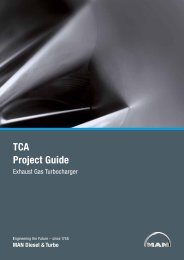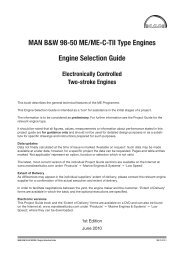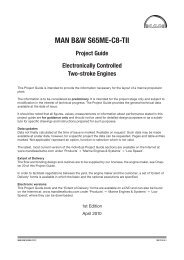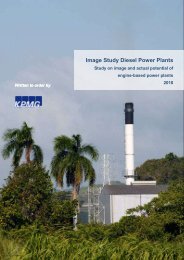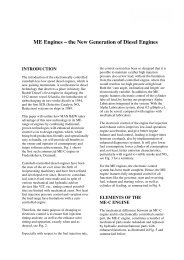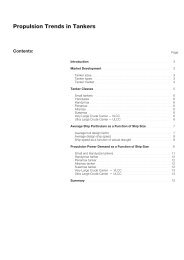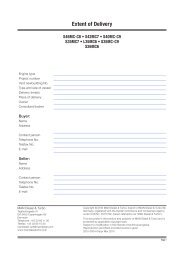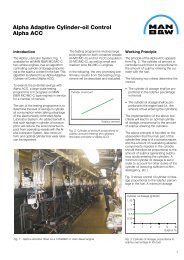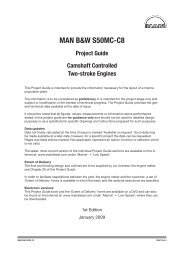This section is available on request - MAN Diesel & Turbo
This section is available on request - MAN Diesel & Turbo
This section is available on request - MAN Diesel & Turbo
You also want an ePaper? Increase the reach of your titles
YUMPU automatically turns print PDFs into web optimized ePapers that Google loves.
<strong>MAN</strong> B&W 15.03<br />
Exhaust Gas System for Main Engine<br />
At the specified MCR of the engine, the total<br />
back�pressure in the exhaust gas system after the<br />
turbocharger (as indicated by the static pressure<br />
measured in the piping after the turbocharger)<br />
must not exceed 350 mm WC (0.035 bar).<br />
In order to have a back�pressure margin for the<br />
final system, it <str<strong>on</strong>g>is</str<strong>on</strong>g> recommended at the design<br />
stage to initially use a value of about 300 mm WC<br />
(0.030 bar).<br />
The actual back�pressure in the exhaust gas<br />
system at specified MCR depends <strong>on</strong> the gas<br />
velocity, i.e. it <str<strong>on</strong>g>is</str<strong>on</strong>g> proporti<strong>on</strong>al to the square of the<br />
exhaust gas velocity, and hence inversely proporti<strong>on</strong>al<br />
to the pipe diameter to the 4th power. It has<br />
by now become normal practice in order to avoid<br />
too much pressure loss in the pipings to have an<br />
exhaust gas velocity at specified MCR of about<br />
35 m/sec, but not higher than 50 m/sec.<br />
For dimensi<strong>on</strong>ing of the external exhaust pipe<br />
c<strong>on</strong>necti<strong>on</strong>s, see the exhaust pipe diameters for<br />
35 m/sec, 40 m/sec, 45 m/sec and 50 m/sec respectively,<br />
shown in Table 5.07.02.<br />
As l<strong>on</strong>g as the total back�pressure of the exhaust<br />
gas system (incorporating all res<str<strong>on</strong>g>is</str<strong>on</strong>g>tance losses<br />
from pipes and comp<strong>on</strong>ents) complies with the<br />
above�menti<strong>on</strong>ed requirements, the pressure<br />
losses across each comp<strong>on</strong>ent may be chosen independently,<br />
see proposed measuring points (M)<br />
in Fig. 5.05.0 . The general design guidelines for<br />
each comp<strong>on</strong>ent, described below, can be used<br />
for guidance purposes at the initial project stage.<br />
Exhaust gas piping system for main engine<br />
The exhaust gas piping system c<strong>on</strong>veys the gas<br />
from the outlet of the turbocharger(s) to the atmosphere.<br />
The exhaust piping <str<strong>on</strong>g>is</str<strong>on</strong>g> shown schematically in<br />
Fig. 5.04.0 .<br />
Page of<br />
The exhaust system for the main engine compr<str<strong>on</strong>g>is</str<strong>on</strong>g>es:<br />
• Exhaust gas pipes<br />
• Exhaust gas boiler<br />
• Silencer<br />
• Spark arrester (if needed)<br />
• Expansi<strong>on</strong> joints (compensators)<br />
• Pipe bracings.<br />
In c<strong>on</strong>necti<strong>on</strong> with dimensi<strong>on</strong>ing the exhaust gas<br />
piping system, the following parameters must be<br />
observed:<br />
• Exhaust gas flow rate<br />
• Exhaust gas temperature at turbocharger outlet<br />
• Maximum pressure drop through exhaust gas<br />
system<br />
• Maximum no<str<strong>on</strong>g>is</str<strong>on</strong>g>e level at gas outlet to atmosphere<br />
• Maximum force from exhaust piping <strong>on</strong><br />
turbocharger(s)<br />
• Sufficient axial and lateral el<strong>on</strong>gati<strong>on</strong> ability of<br />
expansi<strong>on</strong> joints<br />
• Util<str<strong>on</strong>g>is</str<strong>on</strong>g>ati<strong>on</strong> of the heat energy of the exhaust gas.<br />
Items that are to be calculated or read from tables<br />
are:<br />
• Exhaust gas mass flow rate, temperature and maximum<br />
back pressure at turbocharger gas outlet<br />
• Diameter of exhaust gas pipes<br />
• Util<str<strong>on</strong>g>is</str<strong>on</strong>g>ati<strong>on</strong> of the exhaust gas energy<br />
• Attenuati<strong>on</strong> of no<str<strong>on</strong>g>is</str<strong>on</strong>g>e from the exhaust pipe outlet<br />
• Pressure drop across the exhaust gas system<br />
• Expansi<strong>on</strong> joints.<br />
<strong>MAN</strong> B&W MC/MC�C, ME/ME�C/ME�GI/ME-B engines 198 40 74�6.3<br />
<strong>MAN</strong> <strong>Diesel</strong>



